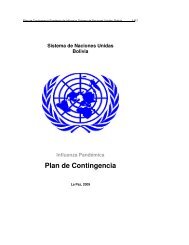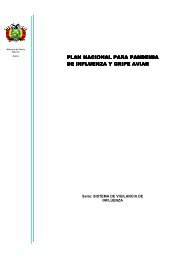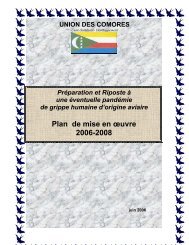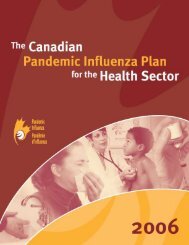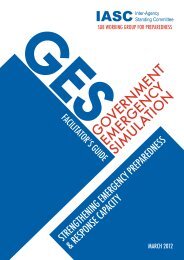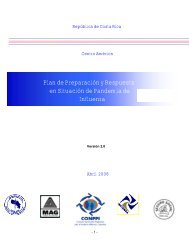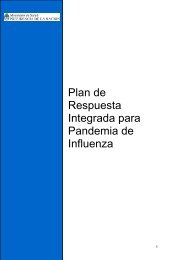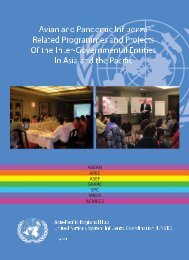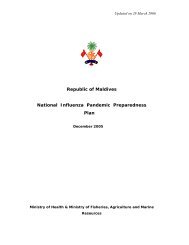Tanzania National Plan (January 2007)[1].pdf - Avian Influenza and ...
Tanzania National Plan (January 2007)[1].pdf - Avian Influenza and ...
Tanzania National Plan (January 2007)[1].pdf - Avian Influenza and ...
You also want an ePaper? Increase the reach of your titles
YUMPU automatically turns print PDFs into web optimized ePapers that Google loves.
<strong>Tanzania</strong> <strong>Avian</strong> <strong>Influenza</strong> <strong>National</strong> Emergency Preparedness & Response <strong>Plan</strong><br />
2.9 Wetl<strong>and</strong>s of <strong>Tanzania</strong><br />
There is a close association between the wild birds that are suspected to be carriers<br />
of <strong>Avian</strong> <strong>Influenza</strong> <strong>and</strong> wetl<strong>and</strong>s. <strong>Tanzania</strong> holds some of the most significant<br />
wetl<strong>and</strong>s in the world that support internationally important biodiversity species of<br />
plants <strong>and</strong> animals, <strong>and</strong> are a vital source of livelihood <strong>and</strong> water for many societies<br />
within <strong>and</strong> outside the country.<br />
The Rift Valley lakes of Tanganyika <strong>and</strong> Nyasa hold some of the most significant<br />
wetl<strong>and</strong>s in the world. They support internationally important assemblages of plants<br />
<strong>and</strong> animals, which are a vital source of livelihood <strong>and</strong> water. The area is about seven<br />
million km 2 of which 4.5 percent is open water/wetl<strong>and</strong>s. A large variety of resident<br />
<strong>and</strong> migratory wetl<strong>and</strong> birds frequent the Rift Valley lakes <strong>and</strong> scattered local<br />
wetl<strong>and</strong>s.<br />
Lake Tanganyika is among the most biodiversity freshwater ecosystems in the world.<br />
It also provides freshwater for domestic, agricultural <strong>and</strong> industrial use <strong>and</strong> up to<br />
200 000 tons of fish annually. Burundi, Democratic Republic of Congo, <strong>Tanzania</strong> <strong>and</strong><br />
Zambia have already embarked on a process to sustainable manage Lake<br />
Tanganyika’s resources, in order to ensure local livelihoods <strong>and</strong> the conservation of<br />
the biodiversity. The Ruvuma river marks the international boundary between<br />
<strong>Tanzania</strong> <strong>and</strong> Mozambique.<br />
The Ruvuma drains an area of about 155 400 km 2 on either side of the border. The<br />
Ruvuma basin marks the interface between the Eastern <strong>and</strong> Southern Africa bio<br />
geographical regions <strong>and</strong> includes lowl<strong>and</strong> coastal forest, diverse types of woodl<strong>and</strong>s,<br />
important wetl<strong>and</strong>s <strong>and</strong> mangrove forests. The Rufiji river basin in southern <strong>Tanzania</strong><br />
is the largest in the country, covering 20 percent of the total l<strong>and</strong> surface. The Rufiji<br />
Basin contains half of all mangroves in <strong>Tanzania</strong>, <strong>and</strong> the floodplain, forests <strong>and</strong><br />
woodl<strong>and</strong>s are home to a rich floral <strong>and</strong> faunal diversity of national <strong>and</strong> international<br />
importance. The Rufiji features a dozen lakes, dotted along the northern shores of the<br />
river, which not only support a productive fishery but help keep the lowl<strong>and</strong> coastal<br />
forests green <strong>and</strong> moist all year round.<br />
3.0 RISK ANALYSIS<br />
This <strong>National</strong> <strong>Avian</strong> <strong>Influenza</strong> Emergency Preparedness <strong>and</strong> Response <strong>Plan</strong> has been<br />
designed to provide direction to <strong>Tanzania</strong>’s efforts strengthen its emergency<br />
preparedness against the eventuality of <strong>Avian</strong> <strong>Influenza</strong> being introduced into this<br />
currently presumed free area. The disease is spread through a number of sources that<br />
include movement of domestic or wild birds <strong>and</strong> bird products through legal or illegal<br />
trade.<br />
<strong>Tanzania</strong> has 42 official ports of entry that include airports, sea ports, lake ports <strong>and</strong><br />
dry l<strong>and</strong> entry ports. Government officers from the Ministries of Health <strong>and</strong> Social<br />
Welfare, Livestock Development, Agriculture <strong>and</strong> Food Security, Home Affairs, Public<br />
Safety <strong>and</strong> Security <strong>and</strong> Natural Resources <strong>and</strong> Tourism supervise many of these<br />
entry <strong>and</strong> exit ports. These officers will need to underst<strong>and</strong> the threat of avian<br />
influenza <strong>and</strong> increase vigilance in preventing entry of this disease to <strong>Tanzania</strong>.<br />
16


![Tanzania National Plan (January 2007)[1].pdf - Avian Influenza and ...](https://img.yumpu.com/36423433/16/500x640/tanzania-national-plan-january-20071pdf-avian-influenza-and-.jpg)
